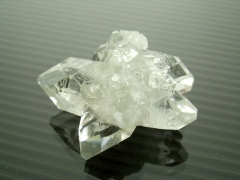 |
 |
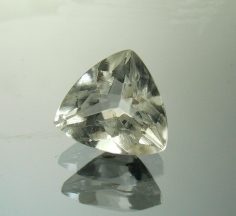 |
 |
| カットの熱で亀裂の入った石 (cracked stone while cutting) | |||
| 結晶(Crystals) 45x40mm | 6.28ct | ルース(faceted
stone) 6.34ct 13.5mm |
束沸石を伴う淡緑色の魚眼石結晶 9x7cm Pale green apophyllite crystal with stilbite |
| Poona, India | |||
魚眼石
(Apophyllite)
 |
 |
 |
 |
| カットの熱で亀裂の入った石 (cracked stone while cutting) | |||
| 結晶(Crystals) 45x40mm | 6.28ct | ルース(faceted
stone) 6.34ct 13.5mm |
束沸石を伴う淡緑色の魚眼石結晶 9x7cm Pale green apophyllite crystal with stilbite |
| Poona, India | |||
| 化学組成 (Composition) |
結晶系 (Crystal System) |
結晶形 (Crystal Form) |
モース硬度 (Hardness) |
比重 (Density) |
屈折率 (Refractive Index) | |
| KCa4(Si8O20)(F,OH)・8H2O | 正方晶系 (Tetragonal) |
 |
 |
4½ - 5 | 2.3-4 | 1.530-538 |
名前と産状(Name and Occurence)
アポフィライトの名はギリシア語の ”apophulliso : 剥れる、葉” に由来します。熱せられると含まれる水分が離散して結晶が木の葉のように薄く剥れることに因んで1806年にフランスの鉱物学者 R.J.アウイが命名しました。和名は結晶面が魚の目のような光沢を持つことに因みます。
魚眼石は玄武岩や安山岩の晶洞中に束沸石等の沸石族、葡萄石、方解石等と共に産します。稀に花崗岩、片麻岩、石灰岩の空隙や、熱水起源の岩石中に発見されます。
The name derives from the Greek word "apophulliso" for "away from" and "leaf", in allusion to the way it exfoliates upon heating.
Apophyllite occurs in cavities in basalt in association with prehnite, calcite, analcime, stilbite and other zeolites. Less commonly in cavities in granite, gneiss and limestone. Also in some hydrothermal veins.
インド・デカン玄武岩の魚眼石 (Apopyllite from Deccan Traps, India)
マハ−ラーシュトラ州の重要鉱物産地
Important mineral localities
of Maharashtra Stateボンベイ周辺の鉱物産地
(Important quarries in
and around Bombay area)インドの地質図(Geographic map of India)
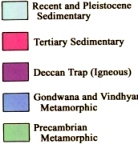 |
更新性(180 - 1万年前)の新しい堆積 | |
| 第三紀(6500 - 180万年前)の堆積 | ||
| デカン玄武岩台地 | ||
| ゴンドワナとヴィンディヤン変成岩 | ||
| 先カンブリア紀(5億7000年以上前)の変成岩 |
インド西南部の150万平方kmに広がるデカン高原は7500万年から4000万年前の間の4度の大規模な火山活動による玄武岩溶岩に覆われています。
ボンベイ近郊と周囲のプーナ、ナシク、ジャルゴン等の玄武岩の晶洞は魚眼石、沸石類、方解石等々の世界的な美しい結晶を産します。
The Deccan plateau, thick basalt layers of about 1.5 million square kilometers of area has been fomed by huge volcanic eruptions, which occured in four phases durng 75 million years ago till about 40 million years ago.
In numerous basalt pockets of Deccan plateau, Nasik, Bombay, Poona and other localities are well known for the production of beautiful crystals of apophyllite, varieties of zeolites, calcite, etc.
緑の魚眼石を産したプーナ南西のパシャン丘陵
Pashan Hills quarry,southwest of Poona,
source of green apophyllite. 1974晶洞に富む玄武岩層 ジャルゴン
Pocket-rich horizons in basalt at Jalgaonプーナ近郊の採石場
Drilling in the face
of a quarry near Poona
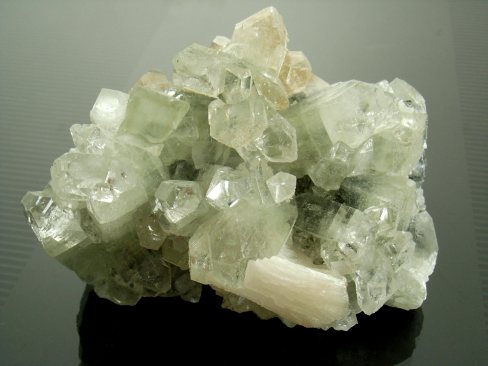 |
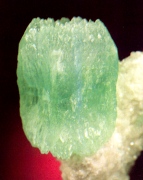 |
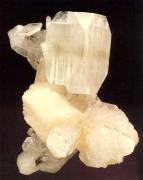 |
| 魚眼石 10cm Apopyllite Jalgaon Ottens Collection |
魚眼石と束沸石 7.8cm Apopyllite with stilbite Jalgaon J.Scovil collection | |
 |
 | |
| 束沸石を伴う魚眼石結晶 プーナ産 13x8cm Apopyllite crystal cluster with stilbite Poona |
ジャルゴン産魚眼石と束沸石 Apopyllite with stilbite Jalgaon | |
| 4.8cm Robert Minerals specimen | 7.1cm S.Fiske collection | |
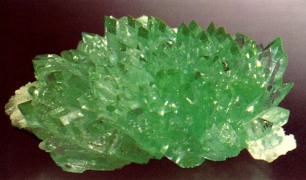 |
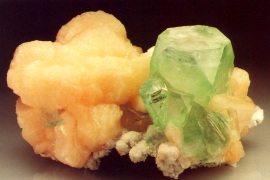 |
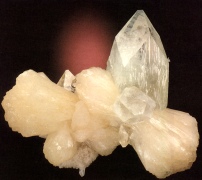 |
| 魚眼石 2.8cm プーナ産 Apopyllite Poona W.Severance collection |
淡緑色の魚眼石と束沸石 ジャルゴン産 Apopyllite with stilbite 13cm Jalgaon Mountain Minerals International specimen |
束沸石上の魚眼石結晶 ナシク産 Apoppyllite with stilbite 8.5cm Nasik John Lucking collection |
魚眼石は基本的には無色の鉱物ですが、金属イオンの不純物により美しく着色されます。
微量のヴァナジウムを含むと淡緑色に発色します。
デカン高原の玄武岩には平均で300ppm程度のヴァナジウムが含まれていますが、プーナでは最大 1600ppm の高い濃度に達し、濃いエメラルド・グリーンの魚眼石となります。
ただし発色の色の濃さを左右するのはヴァナジウムの濃度だけではなく、結晶の形や生成時の温度等の要因が複雑に絡んでいて、単純ではないようです。
プーナ西南のパシャン丘陵は建築材の採石場でしたが、無数の晶洞のために低品質の石材産地でした。ところがその晶洞こそは素晴らしいエメラルド・グリ−ンの魚眼石や沸石類の宝庫でした。
幅100m、高さ50mのごく小規模な産地のため、1970年代から1989年まで20年余りの期間に数百キログラムの結晶標本を産出して閉鎖されました。
ファセット・カットされた魚眼石(Faceted appophyllite)
14.41ct 15.8x13.7mm 11.07ct 13.3x12.5mm
無色であっても数cmに達する魚眼石の透明で端正な姿の結晶は魅力があります。
透明で大きな結晶は大量に採れますが、しかしカットされた魚眼石のルースはついぞ見かけませんでした。 モース硬度が低く完全な劈開性を持つことと、、極めて耐熱性が低くカットの際の摩擦による熱で亀裂が生じ易いためです。その上苦労してカットしたところで屈折率が低いために魅力的な輝きを期待できません。
70年余りの経験がある GIA の研究所でさえ、2004年に6カラット余りのルースを始めて見たとのことですが、それにはテーブル面に達する大きな亀裂が生じているものでした。
冒頭の写真のルースはこの度ようやく入手した亀裂の無いほぼ完璧なものですが、それでもまるで見映えがしません。魚眼石は自然のままの美しい結晶を楽しむべし。
と思っていましたが、上の10カラットを越える二つの完璧なルースはアメリカの難しい石の専門家、アート・グラントのカットしたダイアモンドのようなファイアーを見せる魚眼石です。
屈指のカッターの手練の技にかかると同じ石がこんなにも変わるのですね。
Apophyllite is intrinsically a colorless mineral. But, there are various color varieties, by minor metal impurity. The most significant example is an pale green variety colored by vanadium. Deccan bassalts have an average vanadium content of around 300ppm, while the green apophyllite crystals from Poona are colored by 1600ppm of vanadium(V5+). However, coloring is determined not with single factor of metal impurity, but with other conditions, such as crystal form and crystal growth temperature, etc. etc.
The Pashan quarry near Poona produced superlative grass-green apophyllite crystal clusters of great beauty. From quite small quarries(a large one being 100m long and 50m high), during end 1970 til 1989, they have produced several hundreds kiligrams of zeolite minerals and apophyllite.
Transparent apophyllite crystals up to several centimeter long is also attractive, even colorless. Despite their relative abundance, faceted apophyllite is extremely rare. Because of it's low hardness, difficulty of working due to perfect cleavage, susceptible to heat damage : a friction from grinding and polishing can generate enough heat to cause cracking, and lack of brilliance by relatively low refractive index. GIA laboratory has obtained 6.28ct faceted apophyllite in 2004 for the first time in their 70 years of experience but with large cleavages open to the surface. A perfect faceted stone of the top photo is the one I finally obtined after long patience, and is exactly a stone with dull brilliance as I imagined for the nature of apopyllite.
We had better appreciate the apophyllite in natural crystal form.
Two over 10ct stones are faceted by Art Grant, a leading cutter of rare difficult stones. They look like diamond, thanks to brilliant fires. This is an example of outstanding cutting skill.
| Top | Gemhall |